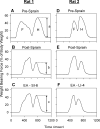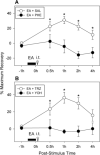Electroacupuncture-induced analgesia in a rat model of ankle sprain pain is mediated by spinal alpha-adrenoceptors
- PMID: 17537577
- PMCID: PMC2268107
- DOI: 10.1016/j.pain.2007.04.034
Electroacupuncture-induced analgesia in a rat model of ankle sprain pain is mediated by spinal alpha-adrenoceptors
Abstract
In a previous study, we showed that electroacupuncture (EA) applied to the SI-6 point on the contralateral forelimb produces long-lasting and powerful analgesia in pain caused by ankle sprain in a rat model. To investigate the underlying mechanism of EA analgesia, the present study tested the effects of various antagonists on known endogenous analgesic systems in this model. Ankle sprain was induced in anesthetized rats by overextending their right ankle with repeated forceful plantar flexion and inversion of the foot. When rats developed pain behaviors (a reduction in weight-bearing of the affected hind limb), EA was applied to the SI-6 point on the contralateral forelimb for 30 min under halothane anesthesia. EA significantly improved the weight-bearing capacity of the affected hind limb for 2h, suggesting an analgesic effect. The alpha-adrenoceptor antagonist phentolamine (2mg/kg, i.p. or 30 microg, i.t.) completely blocked the EA-induced analgesia, whereas naloxone (1mg/kg, i.p.) failed to block the effect. These results suggest that EA-induced analgesia is mediated by alpha-adrenoceptor mechanisms. Further experiments showed that intrathecal administration of yohimbine, an alpha(2)-adrenergic antagonist, reduced the EA-induced analgesia in a dose-dependent manner, whereas terazosin, an alpha(1)-adrenergic antagonist, did not produce any effect. These data suggest that the analgesic effect of EA in ankle sprain pain is, at least in part, mediated by spinal alpha(2)-adrenoceptor mechanisms.
Figures





Similar articles
-
Electroacupuncture reduces the evoked responses of the spinal dorsal horn neurons in ankle-sprained rats.J Neurophysiol. 2011 May;105(5):2050-7. doi: 10.1152/jn.00853.2010. Epub 2011 Mar 9. J Neurophysiol. 2011. PMID: 21389301 Free PMC article.
-
Acupuncture analgesia in a new rat model of ankle sprain pain.Pain. 2002 Oct;99(3):423-431. doi: 10.1016/S0304-3959(02)00164-1. Pain. 2002. PMID: 12406517
-
Electroacupuncture analgesia in rat ankle sprain pain model: neural mechanisms.Neurol Res. 2010 Feb;32 Suppl 1:10-7. doi: 10.1179/016164109X12537002793689. Neurol Res. 2010. PMID: 20034438 Review.
-
Electroacupuncture suppresses capsaicin-induced secondary hyperalgesia through an endogenous spinal opioid mechanism.Pain. 2009 Oct;145(3):332-340. doi: 10.1016/j.pain.2009.06.035. Epub 2009 Jul 30. Pain. 2009. PMID: 19646817 Free PMC article.
-
Electroacupuncture: mechanisms and clinical application.Biol Psychiatry. 1998 Jul 15;44(2):129-38. doi: 10.1016/s0006-3223(97)00394-6. Biol Psychiatry. 1998. PMID: 9646895 Review.
Cited by
-
Electroacupuncture reduces the evoked responses of the spinal dorsal horn neurons in ankle-sprained rats.J Neurophysiol. 2011 May;105(5):2050-7. doi: 10.1152/jn.00853.2010. Epub 2011 Mar 9. J Neurophysiol. 2011. PMID: 21389301 Free PMC article.
-
Spinal cholinergic mechanism of the relieving effects of electroacupuncture on cold and warm allodynia in a rat model of neuropathic pain.J Physiol Sci. 2009 Jul;59(4):291-8. doi: 10.1007/s12576-009-0035-9. Epub 2009 Apr 3. J Physiol Sci. 2009. PMID: 19343482 Free PMC article.
-
A surgical ankle sprain pain model in the rat: effects of morphine and indomethacin.Neurosci Lett. 2008 Sep 12;442(2):161-4. doi: 10.1016/j.neulet.2008.06.074. Epub 2008 Jul 3. Neurosci Lett. 2008. PMID: 18620022 Free PMC article.
-
Caffeine at Moderate Doses Can Inhibit Acupuncture-Induced Analgesia in a Mouse Model of Postoperative Pain.J Caffeine Res. 2013 Sep;3(3):143-148. doi: 10.1089/jcr.2013.0014. J Caffeine Res. 2013. PMID: 24761281 Free PMC article.
-
Acupuncture for ankle sprain: systematic review and meta-analysis.BMC Complement Altern Med. 2013 Mar 4;13:55. doi: 10.1186/1472-6882-13-55. BMC Complement Altern Med. 2013. PMID: 23496981 Free PMC article.
References
-
- Akduman B, Crawford ED. Terazosin, doxazosin, and prazosin: current clinical experience. Urology. 2001;58(6 Suppl 1):49–54. - PubMed
-
- Bossut DF, Huang ZS, Sun SL, Mayer DJ. Electroacupuncture in rats: evidence for naloxone and naltrexone potentiation of analgesia. Brain Res. 1991;549:36–46. - PubMed
-
- Chapman CR, Benedetti C, Colpitts YH, Gerlach R. Naloxone fails to reverse pain thresholds elevated by acupuncture: acupuncture analgesia reconsidered. Pain. 1983;16:13–31. - PubMed
-
- Chapman CR, Colpitts YM, Benedetti C, Kitaeff R, Gehrig JD. Evoked potential assessment of acupunctural analgesia: attempted reversal with naloxone. Pain. 1980;9:183–197. - PubMed
-
- Cheng RSS, Pomeranz B. Monoaminergic mechanism of electroacupuncture analgesia. Brain Res. 1981;215:77–92. - PubMed
Publication types
MeSH terms
Substances
Grants and funding
LinkOut - more resources
Full Text Sources
Other Literature Sources
Medical

